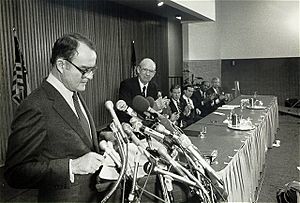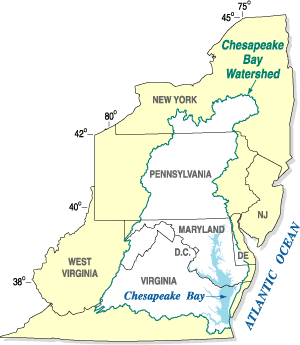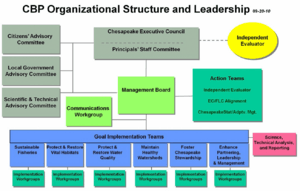Chesapeake Bay Program facts for kids
The Chesapeake Bay Program is a special team that works to make the Chesapeake Bay healthy again. It's like a big partnership that brings together different groups from states, the government, universities, and local communities. They all work together to create and follow plans to restore the Bay. Their main office is in Annapolis, Maryland.
Contents
Why the Chesapeake Bay Program Started

In the late 1970s and early 1980s, the U.S. Congress paid for scientists to study the Chesapeake Bay. Their research showed that the Bay was in trouble. Three main problems needed urgent help:
- Toxic pollution: Harmful chemicals were getting into the water.
- Too many nutrients: Things like nitrogen and phosphorus from farms and sewage were causing too much algae to grow.
- Disappearing bay grasses: Important underwater plants were dying off.
In September 1983, the Environmental Protection Agency (EPA) released a report. It said the Bay was "an ecosystem in decline." This meant that the Bay's natural system was getting worse. The report showed that populations of oysters, crabs, and fish were shrinking.
Because of these problems, in December 1983, the leaders of Maryland, Virginia, and Pennsylvania, along with the mayor of the District of Columbia and the EPA Administrator, signed an important paper called The Chesapeake Bay Agreement of 1983. This agreement created the Chesapeake Bay Program Executive Council, which started the big effort to save the Bay.
How the Program Grew
Since the first agreement in 1983, the Chesapeake Bay Program has made two more big plans to guide its work:
The 1987 Agreement
The 1987 Chesapeake Bay Agreement set a goal to reduce the amount of nutrients (mainly nitrogen and phosphorus) flowing into the Bay by 40 percent by the year 2000. In 1992, the partners decided to keep working on this 40 percent reduction even after 2000. They also decided to focus on stopping nutrients from entering the Bay far upstream, in the rivers that flow into it.
The Chesapeake 2000 Agreement
In June 2000, the Chesapeake Bay Program adopted Chesapeake 2000. This agreement was a plan to guide restoration activities until 2010. It also allowed more states to join the partnership, including Delaware, New York, and West Virginia. These "headwater states" now help reduce nutrients and sediment (dirt and sand) that flow into rivers from their areas.
The Chesapeake 2000 agreement had over 100 specific actions to make the Bay healthier. It was organized into five main parts:
Helping Living Creatures
This part aimed to "restore, improve, and protect" the fish, shellfish, and other living things in the Bay. The goal was to help them thrive and support healthy fishing. For example, one goal was to help the blue crab population grow by managing how many crabs could be caught. They also wanted to increase the native oyster population by ten times and help fish move freely in rivers.
Protecting Important Habitats
This section focused on protecting key places where Bay creatures live. A goal was to protect 114,000 acres (about 460 square kilometers) of submerged aquatic vegetation (underwater grasses). This also meant making the water clearer by 2010. It also included protecting wetlands, forests, and other natural areas.
Improving Water Quality
This part focused on making the water cleaner. Plans included better stormwater management, upgrading wastewater treatment plants to remove more nutrients, and improving sewage systems. The goal was to fix nutrient-related problems by 2010 and remove the Bay from the list of polluted waters.
Smart Land Use
This section talked about permanently protecting 20 percent of the land around the Bay from development by 2010. It also aimed to encourage travel options like biking and bus riding to reduce reliance on cars.
Caring for the Bay
The last part focused on getting people involved. By 2001, they wanted to give information to citizens and community groups so they could help with Bay restoration. Starting in 2005, the program aimed to give every high school student an outdoor experience of the Bay. This was to help them learn about the Bay's problems and how to protect it.
Funding the Program
Since the Chesapeake Bay Program started, the U.S. Congress has provided money each year. Most of the federal funds come from the Environmental Protection Agency and the Department of Agriculture. Other government groups like the Departments of Defense, Interior, and Commerce also provide significant funding. The states of Maryland, Virginia, Delaware, New York, Pennsylvania, West Virginia, and the District of Columbia also contribute money.
Who Are the Partners?
The Chesapeake Bay Program is a huge team effort. Many different groups work together to achieve its goals.
Main Signatories
These are the core partners who signed the original agreements:
- Chesapeake Bay Commission (a group of lawmakers from Maryland, Virginia, and Pennsylvania)
- Commonwealth of Pennsylvania
- Commonwealth of Virginia
- District of Columbia
- State of Maryland
- U.S. Environmental Protection Agency
Headwater State Partners
These states are important because rivers that flow into the Bay start in their areas:
Federal Agency Partners
Many U.S. government agencies help out, including:
- National Aeronautics and Space Administration (NASA)
- U.S. Department of Agriculture
- U.S. Department of Defense
- U.S. Department of the Interior
Academic Institution Partners
Universities and research centers also play a big role, providing scientific knowledge and studies:
- Academy of Natural Sciences
- College of William and Mary
- Pennsylvania State University
- Smithsonian Institution
- University of Maryland
Other Partners
Many non-profit groups and local organizations also work with the program:
- Alliance for the Chesapeake Bay
- Chesapeake Bay Foundation
- Ducks Unlimited
- National Fish and Wildlife Foundation
See also
- Clagett Farm - A project by the Chesapeake Bay Foundation.



